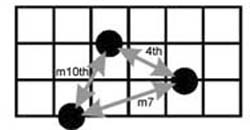« Review: Principles of FFcP |
Main
| 3-note Chord Dominants; Part 1 (Inversions) »
 February 10, 2011 | Three's company. 3-note chord February 10, 2011 | Three's company. 3-note chord
Outside of legendary jazz guitarist Les Paul, there's nothing that demonstrates the "Less is more" better than 3-note chords on the mandolin fretboard. Especially those coming from a guitar background, or even a folk music one, we study the instrument with the notion that we can only get rich, full sound by stroke chords that use all eight strings (four notes), and that becomes a trap. When we think we need four voices in a chord, that actually limits the variations. If you make a formation using the three lowest strings, you can move it up every available fret. You can then double your money by moving that whole block up a string to the three highest ones.
 There's also a sound "Three is enough" harmonic principle in the concept of ensemble playing in mandolin Chord Economics. In a nutshell, of the 7th chord, the bass is being played by a lower voiced instrument, the 5th (unless it's altered) is harmonically insignifcant, and even after voicing the critical 3rd and 7th, you still have an extra voice their to add a color tone 9th, 11th, or 13th, or even another voicing of the root. There's also a sound "Three is enough" harmonic principle in the concept of ensemble playing in mandolin Chord Economics. In a nutshell, of the 7th chord, the bass is being played by a lower voiced instrument, the 5th (unless it's altered) is harmonically insignifcant, and even after voicing the critical 3rd and 7th, you still have an extra voice their to add a color tone 9th, 11th, or 13th, or even another voicing of the root.
If you've considered tackling a 5-string instrument (or 10-course), we urge even more urgency to develop your own system of 3-note voicings. Yes that seems even more counterintuitive, all the extra possibilities with an extra string, but think of what an artist would do with a tray full of colored pencils. Would he/she feel the need to use EVERY pencil? Hardly, the notion would be to explore the paper with just a few carefully chosen colors to express the drawings aesthetic impact. The compulsion to use every pencil would be paralyzing! Think of your fretboard in the same way. Even if you're making a move to a mandola or octave mandolin, the relationships you develop over the fretboard will transpose nicely. You're in essence learning to manipulate 3-note blocks up and down 5ths, anyway.
3-note chords can really be your friend.
We offered an invaluable chart of 3-note chord possibilities a couple years ago with our official JazzMando Chord Staff Researcher, Charlie Jones, and the link bears repeating here. Take advantage of it!
 Conjugating 3 Note Chord Conjugating 3 Note Chord
We also offered a similar concept in our "Grip" series by chord enthusiast and guest contributor, Mark Wilson. For a more complex system of interval relationships, we'd suggest reviewing that, as well.
Article link: GRIP #1
Further:
Limiting your voicing. Three's company
Itching for a 5-string?
New for 5-string and 10-string
Fifths, Symmetry and You: Perceptual Economy
Chord Economics
Posted by Ted at February 10, 2011 1:53 PM

Disclaimer: In the 'Information Age' of the 21st Century,
any fool with a computer, a modem, and an idea can
become a self-professed 'expert." This site does not
come equipped with 'discernment.'
|



